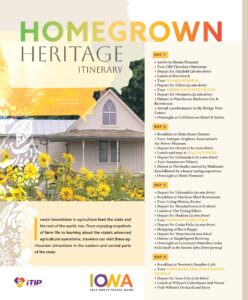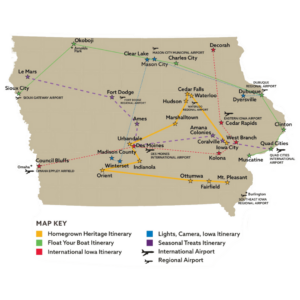Download the Homegrown Heritage Itinerary
Iowa’s innovations in agriculture feed the state and the rest of the world, too. From enjoying snapshots of farm life to learning about the state’s advanced agricultural operations, travelers can visit these agritourism attractions in the eastern and central parts of the state.
- This four-day tour will guide you through a loop of the state, starting in Southeast Iowa, traveling through Central Iowa, and finishing in Eastern Iowa, showcasing some of Iowa’s unique agritourism offerings.
HIGHLIGHTED STOPS
- MAASDAM Barns, Fairfield
- Groups can explore the captivating history of early agriculture at Maasdam Barns in Jefferson County. In 1906, Jacob Maasdam brought Percheron horses to Fairfield, establishing
a renowned horse market. These majestic draft horses, notable for their impressive size and strength, were raised and sold from 1910 to 1938. Today, the Evergreen Ridge Stock Farm at
the Maasdam Barns lets visitors peek into the past to learn about the legacy of the early 20th-century draft horse breeding business. Groups can tour the restored barns on the property,
which were originally constructed in 1906 and 1910 with Louden Machinery Company barn products. Exhibits detailing farm life and the Percheron draft horse breeding business
can be found throughout the farm, including artifacts related to Turney Wagon Works, which was once Fairfield’s largest employer. The barns act as a site for community festivals and
events and draw many visitors to Fairfield each year. (VisitFairfieldIowa.com)
- Groups can explore the captivating history of early agriculture at Maasdam Barns in Jefferson County. In 1906, Jacob Maasdam brought Percheron horses to Fairfield, establishing
- American Gothic House, Eldon
- In 1930, painter Grant Wood visited Eldon, where a particular house caught his eye. That house became the backdrop of one of the nation’s most famous paintings, “American Gothic.”
To this day, the house looks just as it did in the painting, and it’s open to visitors. The on-site American Gothic House Center features an exhibit, a gift shop and costumes to pose
for your very own American Gothic photo (you know you want to!). The house’s exterior is open from dawn to dusk. A few times each month, the interior of the house is opened to
guests. On these dates, visitors can explore the home’s first floor. The center also offers organized group tours. If you’d like to spend some extra time in the great outdoors while
you’re there, the center’s surrounding area includes prairie gardens, a walking and biking trail, picnic areas and disc golf. (AmericanGothicHouse.org)
- In 1930, painter Grant Wood visited Eldon, where a particular house caught his eye. That house became the backdrop of one of the nation’s most famous paintings, “American Gothic.”
- Wallace Farm, Orient
- This vibrant farm was the 1888 birthplace of Henry A. Wallace, who served as U.S. secretary of agriculture from 1933-41 before becoming vice president in 1945. Prior to working
in government, Wallace was one of three generations of Henry Wallaces who left an indelible mark on the field of agriculture. Following in the visionary footsteps of his father and
grandfather, Wallace founded seed-corn company Pioneer Hi-Bred and served as an editor at Wallaces’ Farmer magazine. Wallace Farm as it stands today contains 40 of the property’s
original 160 acres. The farm’s grounds are open daily for self-guided tours. Visitors can explore a sculpture garden, orchard, gardens and a restored prairie. Groups can enjoy a
self-guided tour, an educational program and a farm-to-table meal. Educational programming topics include the Wallaces’ agricultural and journalistic legacies and agricultural history,
or custom lessons on conservation, prairie restoration and other requested topics. (Wallace.org)
- This vibrant farm was the 1888 birthplace of Henry A. Wallace, who served as U.S. secretary of agriculture from 1933-41 before becoming vice president in 1945. Prior to working
- John Deere Tractor & Engine Museum, Waterloo
- John Deere changed life for farmers across the Midwest — and later, the world — when he developed a steel self-scouring plow in 1837. Nearly 200 years later, the company’s larger-than-life tractors and engineering wonders keep America’s farms and industry moving. The John Deere Tractor & Engine Museum stands at the site of John Deere’s very first tractor factory and features a fascinating collection of equipment. The museum’s artifacts chart John Deere’s growth from a simple steel plow to the epic feats of farming the company is known for today. With interactive exhibits and awe-inspiring guides, there’s a whole lot to see. For a more comprehensive museum experience, download the John Deere mobile guide, which offers audio tours, videos, selfie filters and virtual reality experiences throughout the museum. The museum is aptly located at TechWorks, a 30-acre campus of manufacturing, research, innovation and education — so its very surroundings are an inspiration. (ExperienceWaterloo.com)
- Hansen’s Dairy Farm, Hudson
- Hansen’s Dairy Farm has been farmed by the same family for over 150 years across seven generations, which earns it classification as an Iowa Heritage Farm. With an on-farm creamery, Hansen’s is about as farm-to-table as it gets. The farm has been raising cows since the 1950s and has been processing dairy products on-site since 2004. The Hansen family’s four sons help run the farm, caring for a closed dairy herd of 300 Holstein cows and a Wagyu-Holstein herd raised for beef. The creamery produces milk, butter, cheese curds, heavy cream and over 20 flavors of ice cream. The farm also has another special group of critters: kangaroos. After one of the Hansen sons found inspiration on a visit to Australia, the farm became home to several kangaroos, which visitors can pet and feed. Hansen’s offers tours that educate on dairy farming and processing — and of course, each tour offers ample opportunity to pet the cows and kangaroos. (HansenDairy.com)

